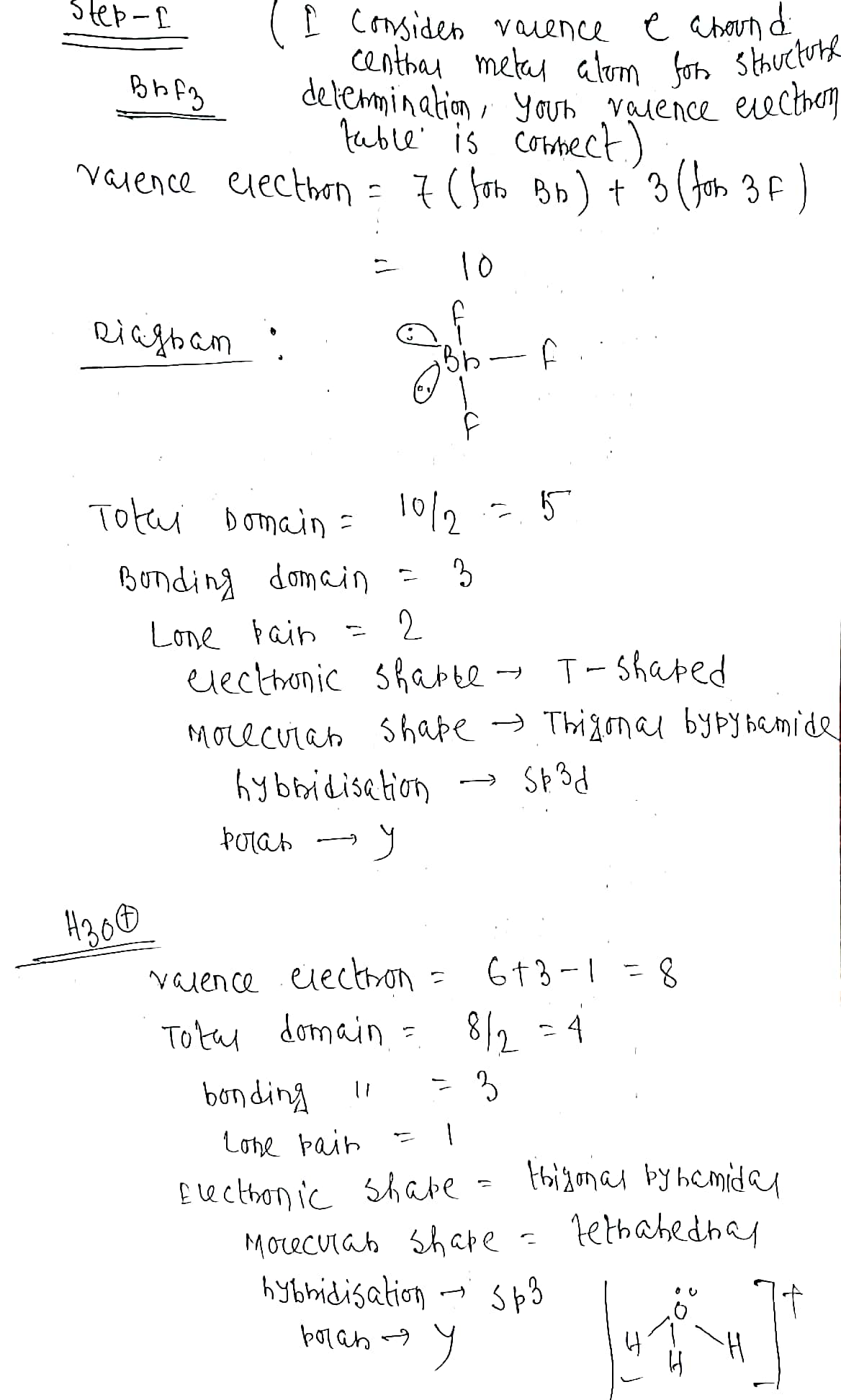Formula Valence Diagram Drawn Total Electronic Molecular Hadridiz-Polar (yor N) Electrons Bonding Domans Lone Domains Pairs Shape abion Shape Br F3 28 On Back 3 T-Shoped sp 3d 2 H3 O+ trigonal Shaped 8. Sp 3 On Back 3 square planar Xe Fu Sp 3d 2 36 On Back trigonal "Pyramidal Sp3d As Ps 40 On Back trigonal planar Sp2 24 Back 5quate Pyrimichal Sp 3d2 エFs 42 On Back bent Sp 2 NO2 On Back 2 1 18 しnear 3 Sp3d| N 2 のIs 22 On Back
Formula Valence Diagram Drawn Total Electronic Molecular Hadridiz-Polar (yor N) Electrons Bonding Domans Lone Domains Pairs Shape abion Shape Br F3 28 On Back 3 T-Shoped sp 3d 2 H3 O+ trigonal Shaped 8. Sp 3 On Back 3 square planar Xe Fu Sp 3d 2 36 On Back trigonal "Pyramidal Sp3d As Ps 40 On Back trigonal planar Sp2 24 Back 5quate Pyrimichal Sp 3d2 エFs 42 On Back bent Sp 2 NO2 On Back 2 1 18 しnear 3 Sp3d| N 2 のIs 22 On Back
Chemistry
10th Edition
ISBN:9781305957404
Author:Steven S. Zumdahl, Susan A. Zumdahl, Donald J. DeCoste
Publisher:Steven S. Zumdahl, Susan A. Zumdahl, Donald J. DeCoste
Chapter1: Chemical Foundations
Section: Chapter Questions
Problem 1RQ: Define and explain the differences between the following terms. a. law and theory b. theory and...
Related questions
Question
Fill in the blank? Learning guidelines

Transcribed Image Text:| Formula | Valence Electrons | Diagram Drawn | Total Domains | Bonding Domains | Lone Pairs | Electronic Shape | Molecular Shape | Hybridization | Polar (Y or N) |
|---------|------------------|---------------|---------------|-----------------|------------|-----------------|-----------------------|---------------|----------------|
| BrF₃ | 28 | On Back | 5 | 3 | 2 | ? | T-shaped | sp³d | Y |
| H₃O⁺ | 8 | On Back | 4 | 3 | 1 | ? | Trigonal shaped | sp³ | Y |
| XeF₄ | 36 | On Back | ? | ? | ? | ? | Square planar | sp³d² | N |
| AsF₅ | 40 | On Back | ? | ? | ? | ? | Trigonal bipyramidal | sp³d | N |
| COF₂ | 24 | On Back | ? | ? | 0 | ? | Trigonal planar | sp² | ? |
| IF₅ | 42 | On Back | 6 | 5 | 1 | ? | Square pyramidal | sp³d² | Y |
| NO₂⁻ | 18 | On Back | 3 | 2 | 1 | ? | Bent | sp² | N |
| I₃⁻ | 22 | On Back | 5 | 2 | 3 | ? | Linear | sp³d | N |
**Explanation:**
- **Formula**: Chemical formula of the molecule or ion.
- **Valence Electrons**: Total number of valence electrons in the molecule/ion.
- **Diagram Drawn**: Appears on the back of the sheet.
- **Total Domains**: Total number of electron pair domains around the central atom.
- **Bonding Domains**: Number of bonding electron domains or shared pairs.
- **Lone Pairs**: Number of lone pairs on the central atom
Expert Solution
Step 1

Step by step
Solved in 4 steps with 4 images

Recommended textbooks for you

Chemistry
Chemistry
ISBN:
9781305957404
Author:
Steven S. Zumdahl, Susan A. Zumdahl, Donald J. DeCoste
Publisher:
Cengage Learning

Chemistry
Chemistry
ISBN:
9781259911156
Author:
Raymond Chang Dr., Jason Overby Professor
Publisher:
McGraw-Hill Education

Principles of Instrumental Analysis
Chemistry
ISBN:
9781305577213
Author:
Douglas A. Skoog, F. James Holler, Stanley R. Crouch
Publisher:
Cengage Learning

Chemistry
Chemistry
ISBN:
9781305957404
Author:
Steven S. Zumdahl, Susan A. Zumdahl, Donald J. DeCoste
Publisher:
Cengage Learning

Chemistry
Chemistry
ISBN:
9781259911156
Author:
Raymond Chang Dr., Jason Overby Professor
Publisher:
McGraw-Hill Education

Principles of Instrumental Analysis
Chemistry
ISBN:
9781305577213
Author:
Douglas A. Skoog, F. James Holler, Stanley R. Crouch
Publisher:
Cengage Learning

Organic Chemistry
Chemistry
ISBN:
9780078021558
Author:
Janice Gorzynski Smith Dr.
Publisher:
McGraw-Hill Education

Chemistry: Principles and Reactions
Chemistry
ISBN:
9781305079373
Author:
William L. Masterton, Cecile N. Hurley
Publisher:
Cengage Learning

Elementary Principles of Chemical Processes, Bind…
Chemistry
ISBN:
9781118431221
Author:
Richard M. Felder, Ronald W. Rousseau, Lisa G. Bullard
Publisher:
WILEY